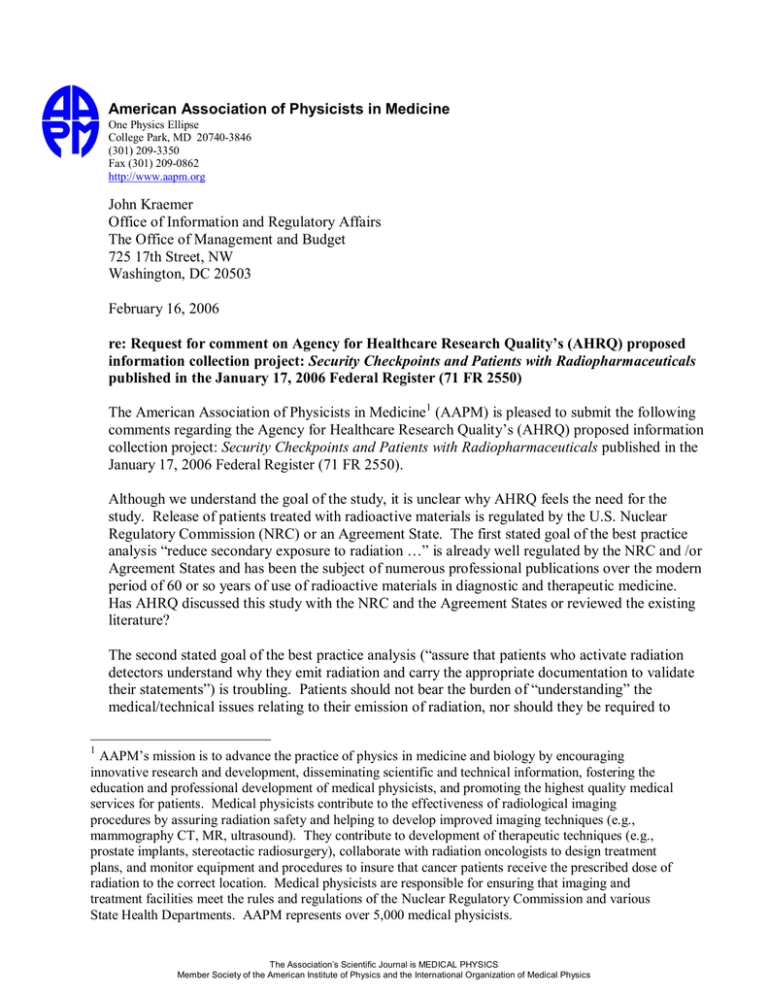American Association of Physicists in Medicine John Kraemer Office of Information and Regulatory Affairs The Office of Management and Budget
advertisement

American Association of Physicists in Medicine One Physics Ellipse College Park, MD 20740­3846 (301) 209­3350 Fax (301) 209­0862 http://www.aapm.org John Kraemer Office of Information and Regulatory Affairs The Office of Management and Budget 725 17th Street, NW Washington, DC 20503 February 16, 2006 re: Request for comment on Agency for Healthcare Research Quality’s (AHRQ) proposed information collection project: Security Checkpoints and Patients with Radiopharmaceuticals published in the January 17, 2006 Federal Register (71 FR 2550) The American Association of Physicists in Medicine 1 (AAPM) is pleased to submit the following comments regarding the Agency for Healthcare Research Quality’s (AHRQ) proposed information collection project: Security Checkpoints and Patients with Radiopharmaceuticals published in the January 17, 2006 Federal Register (71 FR 2550). Although we understand the goal of the study, it is unclear why AHRQ feels the need for the study. Release of patients treated with radioactive materials is regulated by the U.S. Nuclear Regulatory Commission (NRC) or an Agreement State. The first stated goal of the best practice analysis “reduce secondary exposure to radiation …” is already well regulated by the NRC and /or Agreement States and has been the subject of numerous professional publications over the modern period of 60 or so years of use of radioactive materials in diagnostic and therapeutic medicine. Has AHRQ discussed this study with the NRC and the Agreement States or reviewed the existing literature? The second stated goal of the best practice analysis (“assure that patients who activate radiation detectors understand why they emit radiation and carry the appropriate documentation to validate their statements”) is troubling. Patients should not bear the burden of “understanding” the medical/technical issues relating to their emission of radiation, nor should they be required to 1 AAPM’s mission is to advance the practice of physics in medicine and biology by encouraging innovative research and development, disseminating scientific and technical information, fostering the education and professional development of medical physicists, and promoting the highest quality medical services for patients. Medical physicists contribute to the effectiveness of radiological imaging procedures by assuring radiation safety and helping to develop improved imaging techniques (e.g., mammography CT, MR, ultrasound). They contribute to development of therapeutic techniques (e.g., prostate implants, stereotactic radiosurgery), collaborate with radiation oncologists to design treatment plans, and monitor equipment and procedures to insure that cancer patients receive the prescribed dose of radiation to the correct location. Medical physicists are responsible for ensuring that imaging and treatment facilities meet the rules and regulations of the Nuclear Regulatory Commission and various State Health Departments. AAPM represents over 5,000 medical physicists. The Association’s Scientific Journal is MEDICAL PHYSICS Member Society of the American Institute of Physics and the International Organization of Medical Physics educate security personnel on the subject. We also note that creating secure, authenticated documentation to allow security personnel to verify the medical nature of the patient’s emissions is at best impractical and most likely impossible. Rather, the Department of Homeland Security should require that radiation detectors used at security screening locations be capable of identifying the isotope within the patient, thus allowing the security staff to verify the medical nature of the emissions. Such detectors are widely available. We strongly encourage AHRQ to gather data on the frequency of use of such detectors and their efficacy. We appreciate the potential knowledge that might be gained by a publication that described the type and frequency of release instructions given by medical facilities to patients who have received radiopharmaceuticals. That knowledge, however, is unlikely to be relevant to effective security screening procedures, but may be an addition to the already large body of publications regarding exposure from the radiopharmaceutical patient population. AAPM recommends that AHRQ carefully consider the number of facilities in the project as well as selection criteria so that adequate conclusions may be drawn from the diverse universe of thousands of medical institutions providing radiopharmaceutical services to patients. Since AAPM members are integrally involved in decision making and counseling of patients who are released by facilities, AAPM is willing to discuss this proposed data collection effort of ARHQ and to work with ARHQ to obtain the best information available. AAPM thanks you for the opportunity to provide these comments on the proposed rule. If we can be of assistance to you as you proceed with the data collection, please contact me or Lynne Fairobent, AAPM’s Manager of Legislative and Regulatory Affairs at (301) 209­3364 or via email at lynne@aapm.org. Sincerely, Gerald L. White, Jr. Chair AAPM Professional Council The Association’s Scientific Journal is MEDICAL PHYSICS Member Society of the American Institute of Physics and the International Organization of Medical Physics
